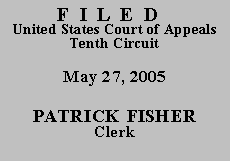

| LESTER WILLIAM NORTONSEN,
Petitioner-Appellant, |
|
| v. | |
| LARRY REID, Warden, and THE
ATTORNEY GENERAL OF THE
STATE OF COLORADO,
Respondents-Appellees. |
|
In April 1994, Nortonsen pled guilty in Colorado state court to one count of child abuse and was sentenced to a term of imprisonment of thirty-six years. Nortonsen did not file a direct appeal. Nortonsen did, however, seek state post-conviction relief on several occasions. Nortonsen's first two attempts at post-conviction relief occurred in 1994 and 1997, respectively. On June 1, 2003, Nortonsen filed a third application for post-conviction relief in Colorado state court. The state district court denied the application on July 7, 2003, and the Colorado Court of Appeals subsequently affirmed the denial of relief on August 5, 2004. Nortonsen also filed a separate petition for writ of habeas corpus with the Colorado Supreme Court, which was denied by that court on April 8, 2004.
On July 12, 2004, Nortonsen prepared and mailed to the federal district court a petition for writ of habeas corpus pursuant to 28 U.S.C. § 2254. That petition was filed by the district court on August 10, 2004. On October 4, 2004, the magistrate judge ordered Nortonsen to show cause why his habeas petition should not be dismissed as untimely pursuant to the one-year limitation period set forth in 28 U.S.C. § 2244(d). Nortonsen submitted a response to the show cause order arguing that his state sentence was "void," and that the federal district court "ha[d] the right to hear the writ at any time for a void sentence because [his] liberty [wa]s violated." ROA, Doc. 6, at 6. On November 24, 2004, the district court dismissed Nortonsen's petition as time-barred under § 2244(d). The district court subsequently denied Nortonsen's request for a COA, as well as Nortonsen's request for leave to proceed in forma pauperis on appeal.
When a district court denies a habeas petition on procedural grounds, a COA will issue only if the prisoner can show that "jurists of reason would find it debatable whether the petition states a valid claim of the denial of a constitutional right and that jurists of reason would find it debatable whether the district court was correct in its procedural ruling." Slack, 529 U.S. at 484. We need not reach the former issue in this case, however, because the record establishes that Nortonsen's habeas petition was untimely. In other words, for the reasons outlined below, we conclude the district court's procedural ruling was correct, and that Nortonsen has thus failed to establish his entitlement to a COA.
Congress has "established a one-year period of limitations for habeas petitions." Hoggro v. Boone, 150 F.3d 1223, 1225 (10th Cir.1998) (citing 28 U.S.C. § 2244(d)(1)). By statute, the one-year period of limitations generally begins running from "the date on which the [state court] judgment became final by the conclusion of direct review or the expiration of the time for seeking such review." 28 U.S.C. § 2244(d)(1)(A). The one-year limitations period is tolled, however, for "[t]he time during which a properly filed application for State post-conviction relief ... is pending," see id. § 2244(d)(2), and may also in rare circumstances "be subject to equitable tolling." Miller v. Marr, 141 F.3d 976, 978 (10th Cir. 1998).
The district court concluded, and we agree, that the one-year limitations period expired well before Nortonsen filed his federal habeas petition. Specifically, because Nortonsen's conviction and sentence became final in 1994 (through expiration of his time for filing a direct appeal), the one-year limitations period in § 2244(d) began running on April 24, 1996. See Serrano v. Williams, 383 F.3d 1181, 1183 (10th Cir. 2004). Although the record on appeal indicates that Nortonsen sought state post-conviction relief at some point in 1997, there is no indication precisely when Nortonsen filed that application. Even assuming the 1997 application was filed prior to the expiration of the one-year limitations period, there is otherwise no indication that the proceedings on that application extended for a lengthy period, and thus no basis for concluding that the proceedings on that application would have served to significantly toll the one-year limitations period. Thus, like the district court, we conclude the one-year limitations period expired before Nortonsen filed his third application for state post-conviction relief in June 2003, and before Nortonsen ultimately filed his federal habeas petition in August 2004.
The application for a COA and the request for leave to proceed in forma pauperis
are DENIED, and the appeal is DISMISSED.
Entered for the Court
Mary Beck Briscoe
Circuit Judge
*.This order is not binding precedent, except under the doctrines of law of the case, res judicata, and collateral estoppel.